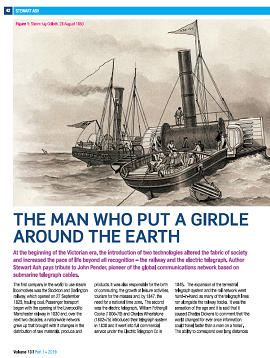The man who put a girdle around the earth

This paper was published in 2019 within the Journal of the Institute of Telecommunications Professionals (Volume 13, Part 1, Pages 42-47) and is made available here with their kind permission.

Introduction
At the beginning of the Victorian era, the introduction of two technologies altered the fabric of society and increased the pace of life beyond all recognition - the railway and the electric telegraph. Author Stewart Ash pays tribute to John Pender, pioneer of the global communications network based on submarine telegraph cables.
The first company in the world to use steam locomotives was the Stockton and Darlington railway, which opened on 27 September 1825, hauling coal. Passenger transport began with the opening of the Liverpool to Manchester railway in 1830 and, over the next two decades, a nationwide network grew up that brought with it changes in the distribution of raw materials, produce and products. It was also responsible for the birth of commuting, the growth of leisure activities, tourism for the masses and, by 1847, the need for a national time zone. The second was the electric telegraph. William Fothergill Cooke (1806-79) and Charles Wheatstone (1802-75) introduced their telegraph system in 1838 and it went into full commercial service under the Electric Telegraph Co in 1845. The expansion of the terrestrial telegraph system and the rail network went hand-in-hand, as many of the telegraph lines ran alongside the railway tracks. It was the sensation of the age and it is said that it caused Charles Dickens to comment that ‘the world changed for ever once information could travel faster than a man on a horse’. The ability to correspond over long distances in relatively short periods of time changed the way business and governments operated.
On 28 August 1850, John Watkins Brett (1805-63) and his brother Jacob (1808-93) laid the first experimental submarine telegraph cable between Dover and Calais from the steam tug Goliath. Although it did not work for long, this event is universally accepted as the start of the submarine cable industry, an industry that the UK would dominate for the next 100 years. British companies would create a global network of submarine cables to increase international trade and, at the same time, expand the colonies that then made up the British Empire. Dubbed ‘The Victorian Intemet’, it was built largely on commercial investment, with very little or no government support. This network of telegraph cables was the forerunner of a global network of fibre optic submarine cables that now carry terabits of data under the oceans and support the internet. If there was one man who could be said to have had the vision to see the benefits to trade and diplomacy of building a global communications network based on submarine telegraph cables, to have the courage to risk his entire fortune in pursuit of his dream, and the tenacity to see it through to fruition, despite many set-backs and personal tragedies, that man was Sir John Pender GCMG (1816-96).
Now click on the link below to download and read a PDF version of the full paper . . . . .
And if you enjoyed reading his paper, you may also like to view Stewart’s presentation entitled, “John Pender, ‘Cable King’, and his Manchester connection” which he presented at the Salford Telecommunications Heritage Conference held on Saturday 22nd June 2019 and is available within the ‘Events’ section of this website.


Follow on social media .....